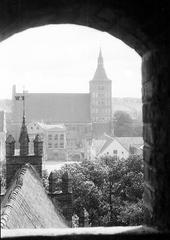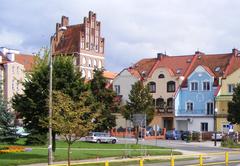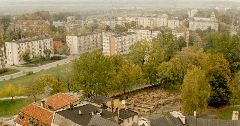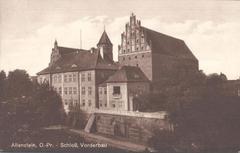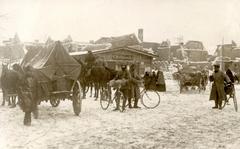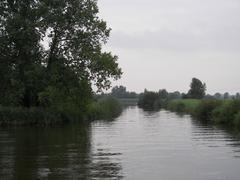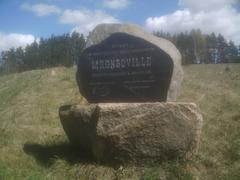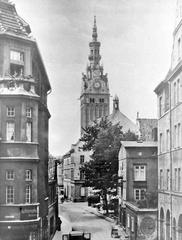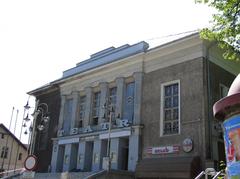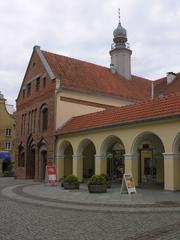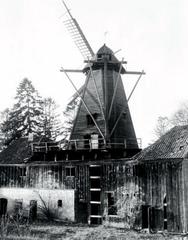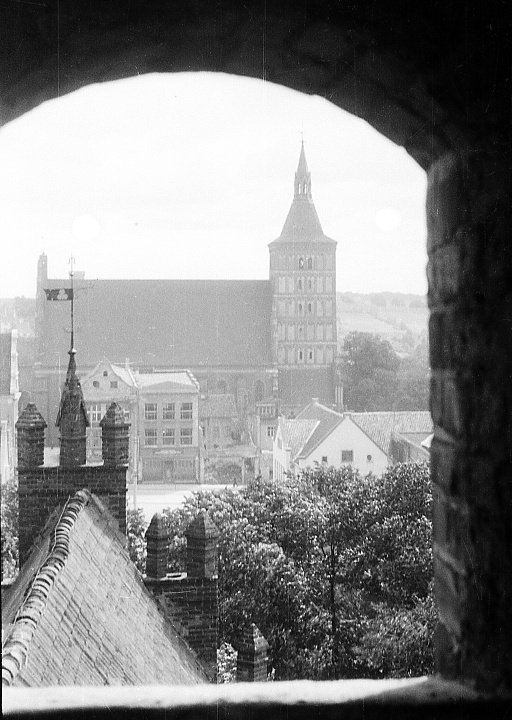
Olsztyn Cathedral Visiting Hours, Tickets, and Historical Sites Guide
Date: 14/06/2025
Introduction
Nestled in the heart of Olsztyn’s Old Town, the Co-Cathedral Basilica of St. James—commonly known as Olsztyn Cathedral—is a masterpiece of Brick Gothic architecture and a symbol of the Warmian-Masurian region’s rich spiritual and cultural heritage. Dating back to the early 14th century, the cathedral has witnessed centuries of religious devotion, artistic evolution, and historical events, making it an essential destination for history enthusiasts, pilgrims, and cultural travelers alike. This guide provides comprehensive visitor information, from opening hours and ticket details to architectural highlights, nearby attractions, and practical travel tips for a memorable visit (polskieszlaki.pl, eurob.org).
Contents
- Historical Overview
- Origins and Construction
- Architectural Features and Evolution
- Notable Events and Conservation
- Visiting Olsztyn Cathedral: Hours, Tickets, and Accessibility
- Nearby Attractions and Local Tips
- Visitor Experience and Etiquette
- Frequently Asked Questions (FAQ)
- Visuals and Interactive Media
- Conclusion and Travel Advice
Historical Overview
Origins and Construction
The construction of Olsztyn Cathedral began in 1315 and continued through the 15th century, established to serve the spiritual needs of the Prince-Bishopric of Warmia during the era of the Teutonic Order. The cathedral’s placement near the Old Town market square underscores its civic and religious importance (polskieszlaki.pl, eurob.org).
Architectural Features and Evolution
Olsztyn Cathedral is a prime example of the Baltic Brick Gothic style, characterized by its red brick facade, stepped gables, and octagonal pillars. The three-nave hall church design, inspired by the Frombork Cathedral, gives the interior a spacious and luminous character. The 16th-century addition of its 60-meter tower enhanced the cathedral’s verticality and architectural prominence (Wikipedia, Lonely Planet).
Noteworthy artistic features include:
- Two Late Gothic winged altars from the 16th century.
- Exquisite stained glass windows that fill the nave with vibrant light.
- Renaissance and Baroque elements such as a marble baptismal font and monumental sculptures.
- A 1913 pulpit and richly decorated pews, representing the cathedral’s evolving artistic narrative (Olsztyn.eu, wildtrips.net).
Notable Events and Conservation
Throughout its history, the cathedral has played a key role in regional and national events. During the Napoleonic Wars, it served as a temporary prison for Russian soldiers, resulting in the loss of many wooden furnishings. Despite damage during WWII, the cathedral survived and underwent significant restoration, including tower repairs and crypt renovations in recent years. Its status was elevated to co-cathedral in 1973 and basilica in 2004, underscoring its importance in the Archdiocese of Warmia (Wikipedia, Finding Poland).
Ongoing conservation efforts, supported by local and national funds, continue to preserve the cathedral’s structural integrity and artistic treasures.
Visiting Olsztyn Cathedral: Hours, Tickets, and Accessibility
- Visiting Hours: Generally open Monday to Saturday from 9:00 AM to 6:00 PM, and Sundays from 7:00 AM to 7:00 PM. Hours may vary on religious holidays—always check the official website or contact the parish before visiting.
- Admission: Entry is free. Donations are welcome to support ongoing maintenance. Special events like organ concerts may require tickets, typically available on-site or online (evendo.com).
- Guided Tours: Available in multiple languages. Book in advance through the cathedral’s website or local tourism offices for an in-depth experience.
- Accessibility: The main entrance is equipped with ramps and the interior features wide aisles, making the cathedral accessible to wheelchair users. Staff are available to assist as needed.
Nearby Attractions and Local Tips
Olsztyn Cathedral is ideally situated in the Old Town, within walking distance of:
- Olsztyn Castle: Explore the historic residence of Nicolaus Copernicus and discover the Warmian Museum’s rich collections.
- Old Town Market Square: Enjoy the vibrant atmosphere, local cuisine, and charming shops.
- Castle Park: Offers scenic views and a peaceful setting for relaxation.
Getting There: Olsztyn is well-connected by train or bus from major Polish cities. The Old Town area is best explored on foot, but public transport and limited parking are available.
Dining and Amenities: Numerous restaurants, cafés, and bakeries are nearby, offering local specialties such as pierogi and freshwater fish. Public restrooms and ATMs are also easily accessible.
Visitor Experience and Etiquette
- Atmosphere: The cathedral’s luminous interior and Gothic vaults offer a tranquil escape from the bustling Old Town.
- Events: Don’t miss the renowned summer organ concerts, which highlight the cathedral’s acoustics and musical heritage.
- Photography: Allowed for personal use—no flash or tripods during services. Be respectful of worshippers.
- Dress Code: Modest attire is required; shoulders and knees should be covered.
Frequently Asked Questions (FAQ)
Q: What are the cathedral’s opening hours?
A: Typically, Monday–Saturday 9:00 AM–6:00 PM, Sunday 7:00 AM–7:00 PM. Verify before visiting.
Q: Is there an admission fee?
A: Entry is free. Donations are appreciated; tickets may be required for concerts and special events.
Q: Are guided tours available?
A: Yes, in several languages. Book in advance for the best experience.
Q: Is the cathedral accessible to people with disabilities?
A: Yes, with ramps and wide aisles. Assistance is available upon request.
Q: Can I take photos inside?
A: Yes, but be discreet and avoid disrupting services.
Visuals and Interactive Media
- Images:
- Exterior view highlighting the Brick Gothic tower (alt: “Olsztyn Cathedral Brick Gothic tower and facade”)
- Interior with webbed vaulting and stained glass (alt: “Interior of Olsztyn Cathedral with Gothic vaulting and stained glass”)
- Close-up of Late Gothic triptychs and stained glass (alt: “Olsztyn historical sites stained glass windows”)
- Interactive Tools:
- Virtual tours and interactive maps are available via official tourism websites.
Conclusion and Travel Advice
Olsztyn Cathedral stands as a testament to the region’s architectural, spiritual, and cultural legacy. Its harmonious blend of Gothic, Renaissance, and Baroque elements, along with its vibrant community life and ongoing restoration, make it a highlight of any visit to northern Poland. Plan your visit to coincide with a concert or festival for an immersive cultural experience, and explore the surrounding Old Town for a deeper appreciation of Olsztyn’s heritage.
Download the Audiala app for guided audio tours and the latest updates on Olsztyn Cathedral and other Polish landmarks. For more travel inspiration, follow us on social media and explore our related articles.
Sources and Further Reading
- Olsztyn Cathedral Visiting Hours, Tickets, and Historical Guide to Olsztyn’s Iconic Monument, 2023, polskieszlaki.pl
- Olsztyn Cathedral Information, 2023, eurob.org
- Co-Cathedral Basilica of St. James in Olsztyn, 2023, Wikipedia
- Olsztyn Cathedral Architectural and Visitor Guide, 2023, Lonely Planet
- Olsztyn Cathedral Basilica Overview, 2023, Olsztyn.eu
- Olsztyn Cathedral Visitor Details, 2023, evendo.com
- Top Things to Do in Olsztyn, 2023, Finding Poland
- 10 Top Things to Do in Olsztyn, 2023, The Unique Poland
- Polish Tourist Organization, 2023, poland.travel
